Research News
-
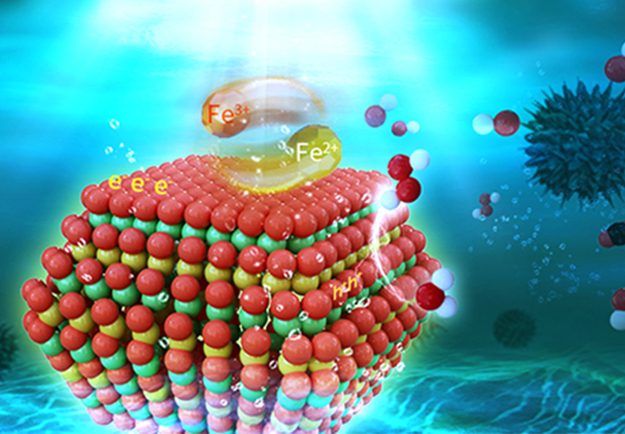 09 13, 2022Researchers Propose New Coupling Strategy for Organic Wastewater TreatmentResearchers has developed a new coupling strategy of photocatalytic water oxidation and catalytic wet peroxide oxidation (Photo-CWPO) for efficient organic wastewater treatment.A joint reseach group led by Prof. SUN Chenglin, Porf. WEI Huangzhao and Prof. LI Rengui's group from the Dalian Institute of Chemical Physics (DICP) of the Chinese Academy of Sciences (CAS) has developed a new coupling strategy of photocatalytic water oxidation and catalytic wet peroxide oxidation (Photo-CWPO) for efficient organic wastewater treatment. This study was published in Applied Catalysis B: Environmental on August 17. CWPO technology is a kind of advanced oxidation process for advanced treatment of organic wastewater using hydroxyl radical (·OH), which is generated from hydrogen peroxide oxidation catalyzed by Fe2+. Nevertheless, low utilization efficiency of H2O2 and difficult iron ions cycling lead to high cost and indirect energy consumption, which limits its further large-scale application. In the proposed Photo-CWPO strategy, efficient circulating of Fe3+/Fe2+ ions was achieved through Fe3+ ions reduction by photogenerated electrons, and meanwhile, photogenerated holes were used to degrade organic pollutants. The researchers used decahedron BiVO4 photocatalyst to realize efficient circulating of Fe3+/Fe2+ ions with selectivity of ~100%, owing to the unique spatial photogenerated charge separation between different facets of the BiVO4 crystal, which inhibited the formation of iron sludge in the traditional CWPO process. H2O2 species could be generated via a two-hole-involved oxidation process of H2O on {110} facets of decahedron BiVO4 crystals during the Fe3+ reduction process on the {010} facets, which could replenish the H2O2 consumption and fully utilize both photogenerated electrons and holes for degradation of pollutions. This strategy achieved a much higher total organic carbon removal rate in the coupling system than CWPO process "The Photo-CWPO strategy could be applied to mineralize various organic pollutants and showed great universality and stability," said Prof. SUN. "We have applied this strategy for the treatment of wastewater from coal chemical industry, methanol to olefin industry and unsymmetrical dimethylhydrazine industry, all of which showed good treatment efficiency," said Prof. WEI. This work is supported by DICP fundings, the National Key Research and Development Program of China, the Youth Innovation Promotion Association, and the National Natural Science Foundation of China. (Text by ZHAO Yue and WANG Yihuan)
09 13, 2022Researchers Propose New Coupling Strategy for Organic Wastewater TreatmentResearchers has developed a new coupling strategy of photocatalytic water oxidation and catalytic wet peroxide oxidation (Photo-CWPO) for efficient organic wastewater treatment.A joint reseach group led by Prof. SUN Chenglin, Porf. WEI Huangzhao and Prof. LI Rengui's group from the Dalian Institute of Chemical Physics (DICP) of the Chinese Academy of Sciences (CAS) has developed a new coupling strategy of photocatalytic water oxidation and catalytic wet peroxide oxidation (Photo-CWPO) for efficient organic wastewater treatment. This study was published in Applied Catalysis B: Environmental on August 17. CWPO technology is a kind of advanced oxidation process for advanced treatment of organic wastewater using hydroxyl radical (·OH), which is generated from hydrogen peroxide oxidation catalyzed by Fe2+. Nevertheless, low utilization efficiency of H2O2 and difficult iron ions cycling lead to high cost and indirect energy consumption, which limits its further large-scale application. In the proposed Photo-CWPO strategy, efficient circulating of Fe3+/Fe2+ ions was achieved through Fe3+ ions reduction by photogenerated electrons, and meanwhile, photogenerated holes were used to degrade organic pollutants. The researchers used decahedron BiVO4 photocatalyst to realize efficient circulating of Fe3+/Fe2+ ions with selectivity of ~100%, owing to the unique spatial photogenerated charge separation between different facets of the BiVO4 crystal, which inhibited the formation of iron sludge in the traditional CWPO process. H2O2 species could be generated via a two-hole-involved oxidation process of H2O on {110} facets of decahedron BiVO4 crystals during the Fe3+ reduction process on the {010} facets, which could replenish the H2O2 consumption and fully utilize both photogenerated electrons and holes for degradation of pollutions. This strategy achieved a much higher total organic carbon removal rate in the coupling system than CWPO process "The Photo-CWPO strategy could be applied to mineralize various organic pollutants and showed great universality and stability," said Prof. SUN. "We have applied this strategy for the treatment of wastewater from coal chemical industry, methanol to olefin industry and unsymmetrical dimethylhydrazine industry, all of which showed good treatment efficiency," said Prof. WEI. This work is supported by DICP fundings, the National Key Research and Development Program of China, the Youth Innovation Promotion Association, and the National Natural Science Foundation of China. (Text by ZHAO Yue and WANG Yihuan) -
 09 09, 2022Lattice Distortion of Perovskite Quantum Dots Induces Coherent Quantum BeatingResearchers recently reported the utilization of lattice distortion in lead halide perovskite quantum dots (QDs) to control their exciton fine structure.A research group led by Prof. WU Kaifeng from the Dalian Institute of Chemical Physics (DICP) of the Chinese Academy of Sciences (CAS), in collaboration with Dr. Peter C. Sercel from the Center for Hybrid Organic Inorganic Semiconductors for Energy, recently reported the utilization of lattice distortion in lead halide perovskite quantum dots (QDs) to control their exciton fine structure.The study was published in Nature Materials on Sept. 8.Lattice distortion in lead halide perovskite quantum dots leads to a fine structure gap and coherent exciton quantum beating (Image by HAN Yaoyao)It is well known that shape or crystal anisotropy in QDs, which are tiny semiconductor nanoparticles, results in energy splitting of their optically bright excitons (bound electron-hole pairs), known as fine structure splitting (FSS). These excitons form an important playground for quantum information science. For example, the excitons' FSS can be exploited for coherent control of quantum states for quantum computing, or for polarization-entangled photon-pairs in quantum optics, although for the latter it is important to suppress the magnitude of splitting. Traditionally, studying FSS usually requires single or just a few QDs at liquid-helium temperature, because of its sensitivity to QD size and shape. Measuring FSS at an ensemble-level, let alone controlling it, seems impossible unless all the dots are made to be nearly identical.In this study, by using ensemble-level femtosecond polarized transient absorption, the researchers observed clear bright-exciton FSS in solution-processed CsPbI3 perovskite QDs, which is manifested as exciton quantum beats (periodic oscillations of kinetic traces)."Even more amazingly, the beat frequency, as determined by the FSS energy, of a given sample can be continuously controlled by changing the temperature. This is an unprecedented result, meaning that now scientists can facilely control FSS through temperature," said Prof. WU. The researchers also found that the temperature-dependent FSS was related to the interesting, highly-dynamic lattice of lead halide perovskites. Lowering the temperature led to a more distorted lead-iodide octahedral framework. Calculations indicated that, because these orthorhombic-phase QDs were actually still bounded by the pseudocubic family of crystal planes, the lattice distortion results in an avoided crossing fine-structure gap between bright exciton. This gap was responsible for the observed FSS, and it could be detected in spite of QD size and shape heterogeneity across an ensemble sample. "Lattice distortion in CsPbI3 perovskites is well known in the photovoltaic community, as it is connected to the issue of phase stability of perovskite solar cells, but nobody has previously connected it experimentally to the exciton fine structure" said Prof. WU. "Our study demonstrates that this material property can actually be harnessed to control the bright-exciton splitting in quantum dots for quantum information technologies."
09 09, 2022Lattice Distortion of Perovskite Quantum Dots Induces Coherent Quantum BeatingResearchers recently reported the utilization of lattice distortion in lead halide perovskite quantum dots (QDs) to control their exciton fine structure.A research group led by Prof. WU Kaifeng from the Dalian Institute of Chemical Physics (DICP) of the Chinese Academy of Sciences (CAS), in collaboration with Dr. Peter C. Sercel from the Center for Hybrid Organic Inorganic Semiconductors for Energy, recently reported the utilization of lattice distortion in lead halide perovskite quantum dots (QDs) to control their exciton fine structure.The study was published in Nature Materials on Sept. 8.Lattice distortion in lead halide perovskite quantum dots leads to a fine structure gap and coherent exciton quantum beating (Image by HAN Yaoyao)It is well known that shape or crystal anisotropy in QDs, which are tiny semiconductor nanoparticles, results in energy splitting of their optically bright excitons (bound electron-hole pairs), known as fine structure splitting (FSS). These excitons form an important playground for quantum information science. For example, the excitons' FSS can be exploited for coherent control of quantum states for quantum computing, or for polarization-entangled photon-pairs in quantum optics, although for the latter it is important to suppress the magnitude of splitting. Traditionally, studying FSS usually requires single or just a few QDs at liquid-helium temperature, because of its sensitivity to QD size and shape. Measuring FSS at an ensemble-level, let alone controlling it, seems impossible unless all the dots are made to be nearly identical.In this study, by using ensemble-level femtosecond polarized transient absorption, the researchers observed clear bright-exciton FSS in solution-processed CsPbI3 perovskite QDs, which is manifested as exciton quantum beats (periodic oscillations of kinetic traces)."Even more amazingly, the beat frequency, as determined by the FSS energy, of a given sample can be continuously controlled by changing the temperature. This is an unprecedented result, meaning that now scientists can facilely control FSS through temperature," said Prof. WU. The researchers also found that the temperature-dependent FSS was related to the interesting, highly-dynamic lattice of lead halide perovskites. Lowering the temperature led to a more distorted lead-iodide octahedral framework. Calculations indicated that, because these orthorhombic-phase QDs were actually still bounded by the pseudocubic family of crystal planes, the lattice distortion results in an avoided crossing fine-structure gap between bright exciton. This gap was responsible for the observed FSS, and it could be detected in spite of QD size and shape heterogeneity across an ensemble sample. "Lattice distortion in CsPbI3 perovskites is well known in the photovoltaic community, as it is connected to the issue of phase stability of perovskite solar cells, but nobody has previously connected it experimentally to the exciton fine structure" said Prof. WU. "Our study demonstrates that this material property can actually be harnessed to control the bright-exciton splitting in quantum dots for quantum information technologies." -
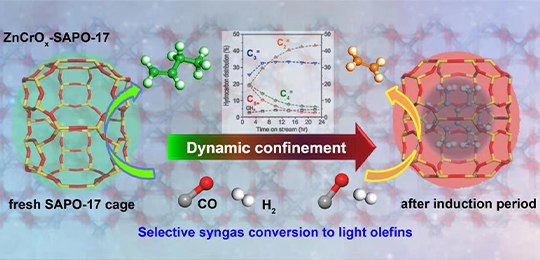 09 07, 2022Researchers Discover Dynamic Confinement of SAPO-17 Cages on Selectivity Control of Syngas ConversionResearchers discovered dynamic confinement of SAPO-17 cages on the selectivity control of syngas conversion, which was observed during an induction period.A research team led by Prof. PAN Xiulian and Prof. BAO Xinhe from the Dalian Institute of Chemical Physics (DICP) of the Chinese Academy of Sciences (CAS) discovered dynamic confinement of SAPO-17 cages on the selectivity control of syngas conversion.This study was published in National Science Review on July 26.In 2016, the team proposed a new catalyst concept based on metal oxide-zeolite bifunctional catalysts (OXZEO), which enabled the direct conversion of syngas to light olefins with high selectivity.In this study, the researchers reported the dynamic confinement effect of zeotype cages, which controlled the product selectivity during the induction period of syngas conversion. They increased the ethylene selectivity from 19% gradually to 44% whereas decreased C4+ hydrocarbon selectivity from 39% to 9% within the first 22 hours on stream. After the induction period, the catalytic performance leveled off.Dynamic confinement of SAPO-17 cages on the selectivity control of syngas conversion (Image by WANG Haodi and JIAO Feng)By the characterization with structured illumination microscopy, intelligent gravimetric analysis, UV-Raman, X-ray diffraction, thermogravimetry, and gas chromatography-mass spectrometer analysis, they indicated that this was induced by the gradual accumulation of carbonaceous species inside the SAPO-17 cages as the reaction proceeds. It led to a gradually decreased free space inside the cage.They found that the diffusion coefficient ratio of C2 to C4 was correlated negatively with an Effective Space Coefficient (ESC), a descriptor that was defined to describe the effective space inside the SAPO-17 cage. It indicated more hindered diffusion for C4 than for C2 with the reduced free space of the cage. Furthermore, a restricted free space would also hinder the secondary reaction of ethylene and therefore benefited C2 selectivity."This study reveals a significant effect of the dynamic confinement of SAPO-17 cage on the product selectivity. Although the most of micropores are occupied (93%) when the induction period is completed, the catalyst is not deactivated and it is running rather stably in syngas conversion," said Prof. PAN.This dynamic confinement is expected to be general for a number of reactions involving hydrocarbons over zeolites. The understanding is essential for further design of high-performance zeolites-based catalysts for C1 chemistry as well as other reactions involving hydrocarbons.This work was supported by the Ministry of Science and Technology of China, the National Natural Science Foundation of China, the Youth Innovation Promotion Association of CAS, Dalian Science and Technology Innovation Fund, the Natural Science Foundation of Liaoning. (Text by WANG Haodi and JIAO Feng)
09 07, 2022Researchers Discover Dynamic Confinement of SAPO-17 Cages on Selectivity Control of Syngas ConversionResearchers discovered dynamic confinement of SAPO-17 cages on the selectivity control of syngas conversion, which was observed during an induction period.A research team led by Prof. PAN Xiulian and Prof. BAO Xinhe from the Dalian Institute of Chemical Physics (DICP) of the Chinese Academy of Sciences (CAS) discovered dynamic confinement of SAPO-17 cages on the selectivity control of syngas conversion.This study was published in National Science Review on July 26.In 2016, the team proposed a new catalyst concept based on metal oxide-zeolite bifunctional catalysts (OXZEO), which enabled the direct conversion of syngas to light olefins with high selectivity.In this study, the researchers reported the dynamic confinement effect of zeotype cages, which controlled the product selectivity during the induction period of syngas conversion. They increased the ethylene selectivity from 19% gradually to 44% whereas decreased C4+ hydrocarbon selectivity from 39% to 9% within the first 22 hours on stream. After the induction period, the catalytic performance leveled off.Dynamic confinement of SAPO-17 cages on the selectivity control of syngas conversion (Image by WANG Haodi and JIAO Feng)By the characterization with structured illumination microscopy, intelligent gravimetric analysis, UV-Raman, X-ray diffraction, thermogravimetry, and gas chromatography-mass spectrometer analysis, they indicated that this was induced by the gradual accumulation of carbonaceous species inside the SAPO-17 cages as the reaction proceeds. It led to a gradually decreased free space inside the cage.They found that the diffusion coefficient ratio of C2 to C4 was correlated negatively with an Effective Space Coefficient (ESC), a descriptor that was defined to describe the effective space inside the SAPO-17 cage. It indicated more hindered diffusion for C4 than for C2 with the reduced free space of the cage. Furthermore, a restricted free space would also hinder the secondary reaction of ethylene and therefore benefited C2 selectivity."This study reveals a significant effect of the dynamic confinement of SAPO-17 cage on the product selectivity. Although the most of micropores are occupied (93%) when the induction period is completed, the catalyst is not deactivated and it is running rather stably in syngas conversion," said Prof. PAN.This dynamic confinement is expected to be general for a number of reactions involving hydrocarbons over zeolites. The understanding is essential for further design of high-performance zeolites-based catalysts for C1 chemistry as well as other reactions involving hydrocarbons.This work was supported by the Ministry of Science and Technology of China, the National Natural Science Foundation of China, the Youth Innovation Promotion Association of CAS, Dalian Science and Technology Innovation Fund, the Natural Science Foundation of Liaoning. (Text by WANG Haodi and JIAO Feng) -
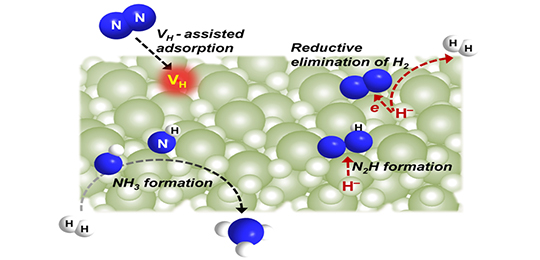 09 05, 2022Transition-Metal-Free Barium Hydride Mediates Dinitrogen Fixation and Ammonia SynthesisResearchers synthesized ammonia via a chemical looping process mediated by a transition-metal-free barium hydride (BaH2) and revealed its mechanism.Ammonia is crucial for the manufacture of nitrogen fertilizers and is also widely regarded as promising energy or hydrogen carrier. Due to the high energy consumption of industrial ammonia production, the development of alternative materials and approaches for efficient N2 reduction to ammonia under mild conditions is a long-sought goal. Main group elements are notable for their abundance in the Earth's crust and environmentally benign nature. Because of new dinitrogen reaction chemistry, the employment of main group elements for this vital reaction has recently aroused great interest. Recently, a research group led by Prof. CHEN Ping and Prof. GUO Jianping from the Dalian Institute of Chemical Physics (DICP) of the Chinese Academy of Sciences, in collaboration with Prof. Tejs Vegge from Technical University of Denmark synthesized ammonia via a chemical looping process mediated by a transition-metal-free barium hydride (BaH2) and revealed its mechanism.This study was published in Angewandte Chemie International Edition on August 2.
09 05, 2022Transition-Metal-Free Barium Hydride Mediates Dinitrogen Fixation and Ammonia SynthesisResearchers synthesized ammonia via a chemical looping process mediated by a transition-metal-free barium hydride (BaH2) and revealed its mechanism.Ammonia is crucial for the manufacture of nitrogen fertilizers and is also widely regarded as promising energy or hydrogen carrier. Due to the high energy consumption of industrial ammonia production, the development of alternative materials and approaches for efficient N2 reduction to ammonia under mild conditions is a long-sought goal. Main group elements are notable for their abundance in the Earth's crust and environmentally benign nature. Because of new dinitrogen reaction chemistry, the employment of main group elements for this vital reaction has recently aroused great interest. Recently, a research group led by Prof. CHEN Ping and Prof. GUO Jianping from the Dalian Institute of Chemical Physics (DICP) of the Chinese Academy of Sciences, in collaboration with Prof. Tejs Vegge from Technical University of Denmark synthesized ammonia via a chemical looping process mediated by a transition-metal-free barium hydride (BaH2) and revealed its mechanism.This study was published in Angewandte Chemie International Edition on August 2.
Transition-metal-free dinitrogen fixation mediated by barium hydride (Image by GUAN Yeqin)Alkali or alkaline earth metal hydrides can fix N2 forming corresponding metal imides and H2. The metal imides then undergo hydrogenation to NH3 and metal hydrides. However, the reaction mechanisms of N2 activation, H2 release and NH3 formation over alkali hydrides are still unclear.The researchers indicated that the creation of hydrogen vacancies played an important role in N2 fixation process mediated by BaH2. The creation of hydrogen vacancies led to the formation of multiple coordinatively unsaturated Ba sites, which were responsible for the adsorption and activation of N2. The hydridic hydrogen acted as an electron donor and facilitates the activation of N2 with concurrent H2 release. They found that the process functionally resembled the molecular hydrido complexes and FeMo cofactor in nitrogenase. Both the hydridic hydrogen and gaseous H2 were involved in the NH3 formation process. "This is a helpful model for understanding the activation and hydrogenation of N2 to NH3 mediated by alkali and alkaline earth metal hydrides, which has prospects in future technologies for nitrogen fixation using transition-metal-free materials," said Prof. CHEN.This work was supported by the National Natural Science Foundation of China and the Youth Innovation Promotion Association of CAS. (Text GUAN Yeqin) -
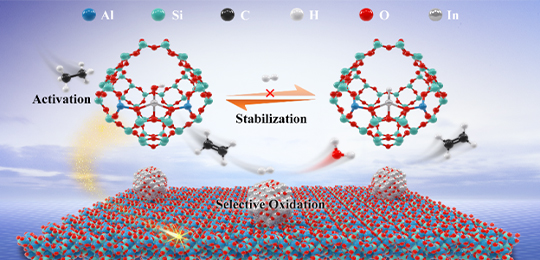 08 31, 2022Researchers Tailor Main-group Catalyst with Atomically Dispersed In Sites for Highly Efficient Oxidative DehydrogenationResearchers proposed and demonstrated a new concept to achieve high alkenes yields by regulating the activation of intrinsically selective catalyst for alkanes from weakness to strength.
08 31, 2022Researchers Tailor Main-group Catalyst with Atomically Dispersed In Sites for Highly Efficient Oxidative DehydrogenationResearchers proposed and demonstrated a new concept to achieve high alkenes yields by regulating the activation of intrinsically selective catalyst for alkanes from weakness to strength.
Transition metal oxides are a kind of catalysts for oxidative dehydrogenation of alkanes. However, they suffer from inferior alkenes yield due to the trade-off between conversion and selectivity induced by more reactive alkenes than alkanes.
Recently, a group led by Prof. WANG Xiaodong and Prof. ZHANG Tao from the Dalian Institute of Chemical Physics (DICP) of the Chinese Academy of Sciences (CAS) proposed and demonstrated a new concept to achieve high alkenes yields by regulating the activation of intrinsically selective catalyst for alkanes from weakness to strength.
This study was published in J. Am. Chem. Soc. on Aug. 25, and was selected as Inner Cover.
Schematic of the local coordination environment of isolated In site and proposed selective oxidative dehydrogenation process on main-group In catalyst (Image by WANG Chaojie)The researchers designed a main-group catalyst with atomically dispersed In sites to disentangle the dilemma of trade-off between activity and selectivity in oxidative dehydrogenation process. This novel catalyst exhibited exceeding 80% C2H4 selectivity at around 80% C2H4 conversion, thus achieving more than 60% C2H4 yield, which outperformed the state-of-the-art transition metal oxide catalysts.Moreover, the researchers found that atomically dispersed [InOH]2+ sites anchored by substituting the protons of supercages in HY enabled the activation of ethane via significantly lowering the barrier of ethane dissociation and their structure could be stabilized by H2O formed from selective oxidation of hydrogen by In2O3 nanoparticles, thus exhibiting excellent performance for oxidative dehydrogenation of ethane."Our study unlocks new opportunities for the utilization of main-group elements and paves the way toward more rational design of catalysts for highly efficient selective oxidation catalysis," said Prof. WANG.This work was supported by the National Natural Science Foundation of China, the Strategic Priority Research Program of the Chinese Academy of Sciences and Dalian Science Foundation for Distinguished Young Scholars. (Text by TIAN Ming) -
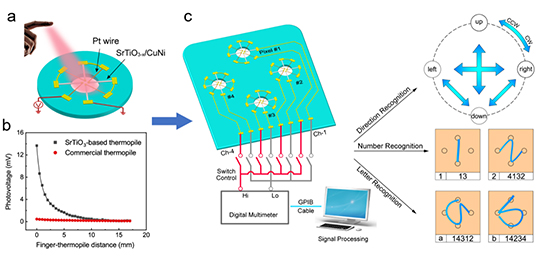 08 30, 2022Long-wave Infrared Detector Enables Non-contact Human-machine InteractionResearchers designed a highly sensitive long-wave infrared detector which enables the low-power non-contact human-machine interaction.The thermal radiation emitted by human body is predominantly in the long-wave infrared region (8-14 μm), which is characterized by low photon energy and low power intensity.Recently, a research team led by Associate Prof. LU Xiaowei, Prof. JIANG Peng and Prof. BAO Xinhe from the Dalian Institute of Chemical Physics (DICP) of the Chinese Academy of Sciences (CAS) designed a highly sensitive long-wave infrared detector that enables the low-power non-contact human-machine interaction.This study was published in Advanced Materials on July 11.As a type of thermal detector, the photothermoelectric (PTE) detector is well-known for its broadband spectral response in the uncooled and self-powered operating mode, which involves two separate energy conversion processes: photothermal and thermoelectric conversions.The commercial PTE detectors typically employ the thermopile arrangement to multiply the voltage signal and require the complex micro-electro-mechanical systems (MEMS) fabrication technique. When detecting the weak human radiation, an additional acquisition circuit with high signal-to-noise ratio is usually applied due to the small voltage signal (around tens or hundreds of microvolts).SrTiO3-x/CuNi composite-based thermopile array enables the non-contact recognition of hand gestures, numbers, and letters (Image by GUO Xiaohan and LU Xiaowei)In this work, the researchers designed a novel thermopile based on the SrTiO3-x/CuNi heterostructure. On one hand, this heterostructure synergistically coupled the high electrical conductivity of CuNi alloy with high Seebeck coefficient of SrTiO3-x. On the other hand, this heterostructure exhibited broadband optical absorption ability, due to the combination of free carrier absorption and phonon resonance absorption. Benefiting from these features, the SrTiO3-x/CuNi-based thermopile exhibited high sensitivity to human radiation. The output signal level reached up to 13 mV, with the noise voltage being 10 nV/Hz1/2. A thermopile array was further constructed to implement the noncontact real-time recognitions of hand gestures, Arabic numbers and alphabet letters. "This work offers a reliable strategy to integrate the human radiation into noncontact human–machine interaction, which may play vital roles in certain human-machine interaction fields where hygiene and security become crucial concerns," said Prof. JIANG.This work was supported by the National Natural Science Foundation of China, CAS Interdisciplinary Innovation Team, and DICP. (Text by GUO Xiaohan and LU Xiaowei)
08 30, 2022Long-wave Infrared Detector Enables Non-contact Human-machine InteractionResearchers designed a highly sensitive long-wave infrared detector which enables the low-power non-contact human-machine interaction.The thermal radiation emitted by human body is predominantly in the long-wave infrared region (8-14 μm), which is characterized by low photon energy and low power intensity.Recently, a research team led by Associate Prof. LU Xiaowei, Prof. JIANG Peng and Prof. BAO Xinhe from the Dalian Institute of Chemical Physics (DICP) of the Chinese Academy of Sciences (CAS) designed a highly sensitive long-wave infrared detector that enables the low-power non-contact human-machine interaction.This study was published in Advanced Materials on July 11.As a type of thermal detector, the photothermoelectric (PTE) detector is well-known for its broadband spectral response in the uncooled and self-powered operating mode, which involves two separate energy conversion processes: photothermal and thermoelectric conversions.The commercial PTE detectors typically employ the thermopile arrangement to multiply the voltage signal and require the complex micro-electro-mechanical systems (MEMS) fabrication technique. When detecting the weak human radiation, an additional acquisition circuit with high signal-to-noise ratio is usually applied due to the small voltage signal (around tens or hundreds of microvolts).SrTiO3-x/CuNi composite-based thermopile array enables the non-contact recognition of hand gestures, numbers, and letters (Image by GUO Xiaohan and LU Xiaowei)In this work, the researchers designed a novel thermopile based on the SrTiO3-x/CuNi heterostructure. On one hand, this heterostructure synergistically coupled the high electrical conductivity of CuNi alloy with high Seebeck coefficient of SrTiO3-x. On the other hand, this heterostructure exhibited broadband optical absorption ability, due to the combination of free carrier absorption and phonon resonance absorption. Benefiting from these features, the SrTiO3-x/CuNi-based thermopile exhibited high sensitivity to human radiation. The output signal level reached up to 13 mV, with the noise voltage being 10 nV/Hz1/2. A thermopile array was further constructed to implement the noncontact real-time recognitions of hand gestures, Arabic numbers and alphabet letters. "This work offers a reliable strategy to integrate the human radiation into noncontact human–machine interaction, which may play vital roles in certain human-machine interaction fields where hygiene and security become crucial concerns," said Prof. JIANG.This work was supported by the National Natural Science Foundation of China, CAS Interdisciplinary Innovation Team, and DICP. (Text by GUO Xiaohan and LU Xiaowei)